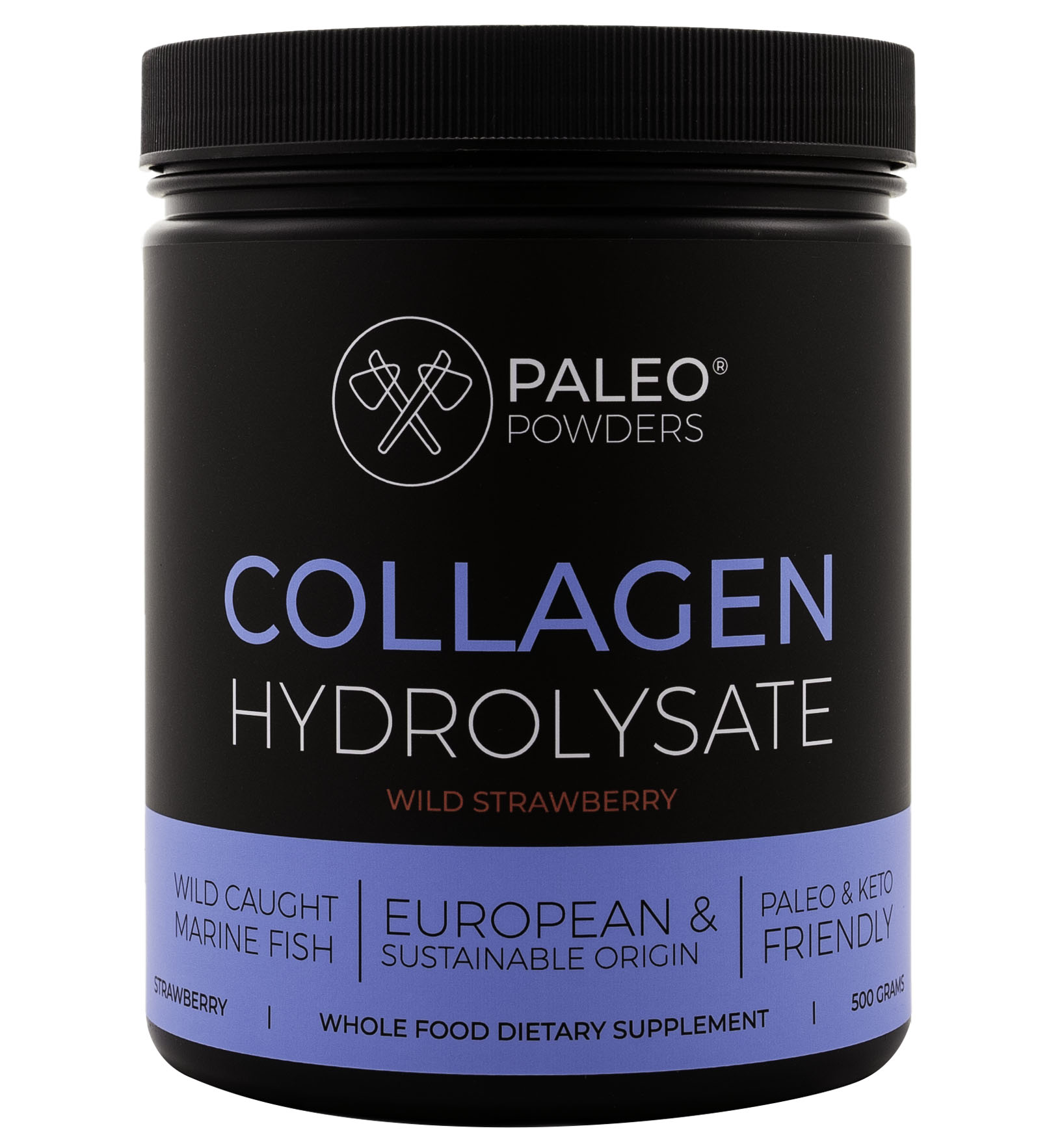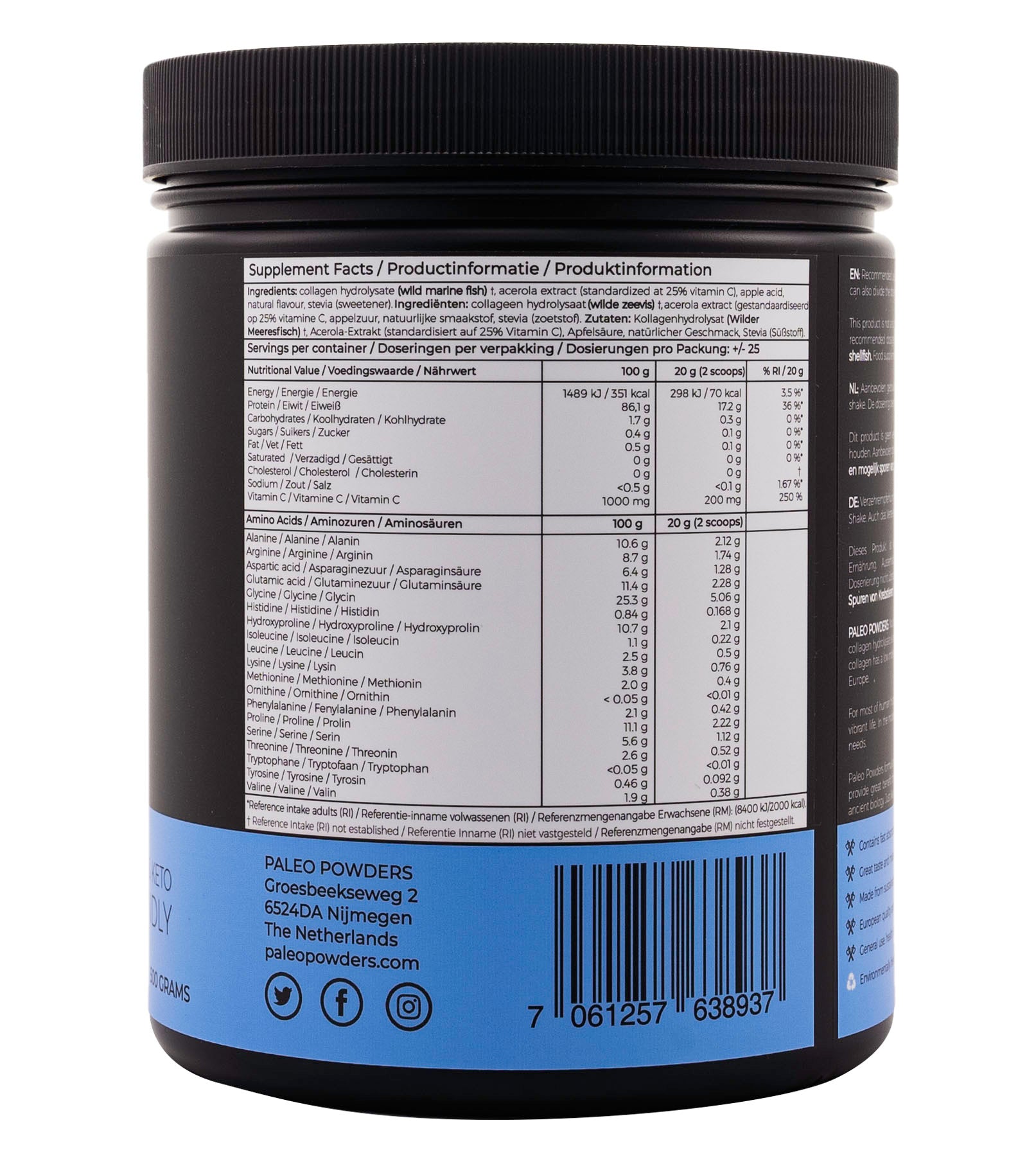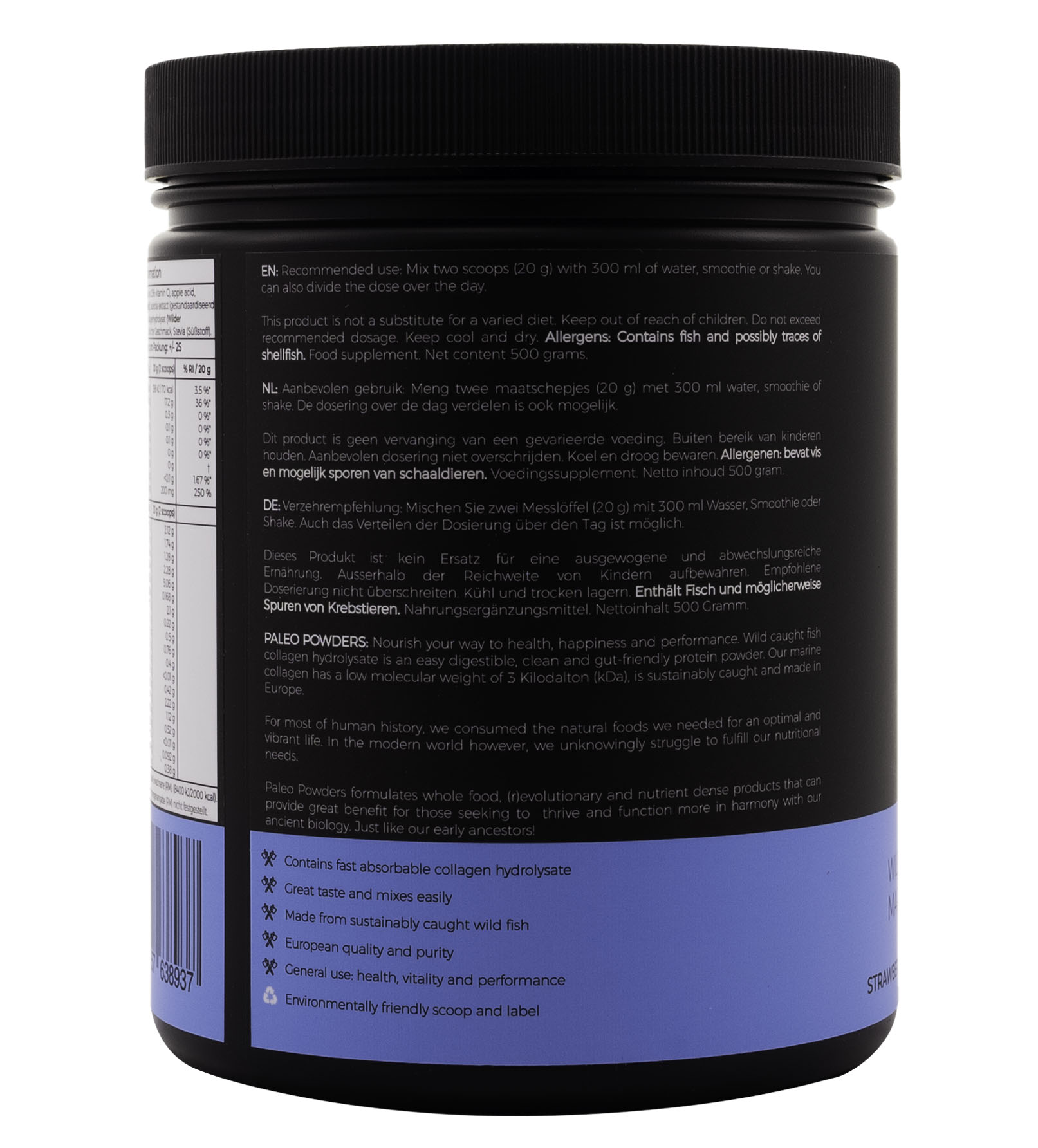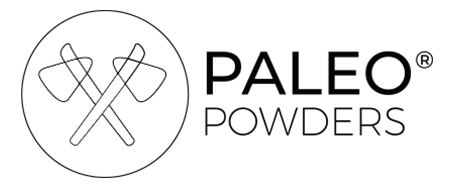


Collageen Hydrolysaat - Wild Gevangen Vis - Aardbei - 500 gram
Wil je het ultieme all-in-one supplement voor je lichaam ontdekken? Dan is Collageen Hydrolysaat met natuurlijke vitamine C misschien iets voor jou! Dit krachtige supplement bevat het meest voorkomende eiwit in ons lichaam, collageen, dat ongeveer 25% tot 35% van de eiwitten in ons bindweefsel, huid, botten en pezen uitmaakt.
Wat maakt collageen zo bijzonder? Collageen heeft een unieke samenstelling van aminozuren die specifiek onze collageenrijke delen voeden, zoals onze huid, haren en nagels. Daarnaast komt de naam "collageen" van het Griekse woord "colla", wat "lijm" betekent, omdat collageen fungeert als de "cellulaire lijm" die alle bindweefsel in ons lichaam bij elkaar houdt.
Collageen speelt een belangrijke rol bij het versterken van de kracht, stevigheid en elasticiteit van ons bindweefsel, niet alleen in onze huid, maar ook in onze botten, spieren, pezen, kraakbeen, nagels, tanden en organen, inclusief ons hele spijsverteringsstelsel. De aminozuren in collageen zijn de bouwstenen van deze structuren en dragen bij aan het behoud van een gezond lichaam.
Als je op zoek bent naar een supplement dat je lichaam op meerdere manieren kan ondersteunen, dan is Collageen Hydrolysaat met natuurlijke vitamine C een goede keuze!
VOORDELEN VAN COLLAGEEN VAN WILD GEVANGEN VIS:
- Krachtige nutricosmetica die het lichaamseigen collageennetwerk ondersteunt
- Natuurlijke wilde aardbeismaak gezoet met stevia voor een heerlijke smaak
- Hoogwaardige bron van eiwitten
- Hoge concentratie aminozuren glycine, lysine en proline
- Duurzame bron van wild gevangen vis uit Europa
- Type I collageen
- Bevat natuurlijke vitamine C uit Acerola om de collageenproductie te ondersteunen
- Laag molecuulgewicht (3kDa) voor snelle opname en effectiviteit
- Makkelijk oplosbaar in water, zonder gluten, soja of kunstmatige toevoegingen.
NATUURLIJKE VITAMINE C
Deze formulering bevat naast natuurlijke vitamine C ook de natuurlijke zoetstof Stevia en heeft een lichte en frisse aardbeiensmaak. De collageen mengt gemakkelijk met vloeistoffen en wordt snel door het lichaam opgenomen door het lage moluculaire gewicht (3kDa). Binnen enkele minuten beschikt het lichaam over specifieke aminozuren en verbindingen die het direct kan inzetten!
Collageen Hydrolysaat zorgt voor de perfecte ondersteuning voor de huid, haar en nagels. Het behoort dan ook tot de categorie nutricosmetica. Collageen is echter breed inzetbaar en er worden talrijke andere lichaamsprocessen ondersteund. De collageen van Paleo Powders bevat specifiek type I collageen van duurzame Europese herkomst.
NUTRICOSMETICA
Nutricosmetica is een categorie van supplementen die speciaal gericht zijn op de uiterlijke verzorging van binnen uit. Het gaat meestal om producten die worden gebruikt voor de huid, haren en nagels. Onder nutricosmetica vallen verschillende vormen van natuurlijke voedingssupplementen, zoals collageen en bone broth die je inneemt. Door collageen en bone broth met elkaar te combineren creëer je een nutricosmetica stack die vanuit verschillende invalshoeken zijn werk doet: deze supplementen hebben namelijk een synergetisch effect op elkaar. 1 + 1 = 3!
ONDERHOUD VOOR HET LICHAAM
Collageen is dus niet alleen een nutri-cosmetisch product maar zoals gezegd een ware all-in-one superster voor je lichaam. Collageen dat je via voeding of supplementen binnenkrijgt verhoogt je lichaamseigen collageen voorraad op natuurlijke wijze. Het lichaam kan zelf collageen aanmaken, echter beginnen we vanaf 25 jaar minder van dit belangrijke eiwit aan te maken totdat ons lichaam op 50-jarige leeftijd bijna geen collageen meer aanmaakt.
Het op peil houden van goede niveaus en een toereikende dagelijkse inname van collageen is een interessant onderdeel van de verzorgende voeding die het lichaam evolutionair gewend is.
WAAROM HEB JE COLLAGEEN NODIG?
- Alle weefsels in je lichaam, dus ook het collageen, heeft input en voldoende voeding nodig om optimaal te kunnen functioneren.
- Naar mate je ouder wordt daalt het vermogen van je lichaam om collageen aan te maken.
- Collageen is een belangrijk eiwit dat veelal ontbreekt in de dagelijkse voeding. Collageen en de specifieke aminozuren brengen balans in de eiwit-aminozuurinname. Dit is specifiek toe te schrijven aan de L-Methionine en Glycine verhoudingen. Collageen is erg rijk aan de laatste.
UPGRADE JEZELF VAN BINNENUIT
Het verhogen van je collageen inname is niet beperkt tot alleen maar voedingssupplementen. Je kunt bijvoorbeeld ook zelf bottenbouillon (bone broth) en stoofschotels maken, of stuggere vleesdelen eten in plaats van de filets. Het gebruik van collageen hydrolysaat voedingssupplementen is vooral erg praktisch en tijdbesparend. Collageen hydrolysaat van wilde vis is hiervoor een uitstekende keuze om snel en eenvoudig je dagelijkse voeding aan te vullen met belangrijke aminozuren.
GLYCINE, LYSINE & (HYDROXY)PROLINE
Ook al bevat collageen hydrolysaat niet alle essentiële aminozuren, het bevat wel drie aminozuren die je niet in dezelfde mate in andere eiwitbronnen kunt vinden. Met name de hoge concentraties aan glycine, proline en hydroxproline maken collageen uniek. Deze drie aminozuren komen in plantaardige voeding slechts in kleine hoeveelheden voor. Glycine, proline en hydroxyproline zijn de drie meest voorkomende aminozuren in collageen. In het menselijk lichaam vind je deze drie aminozuren ongeveer in de ongeveer dezelfde verhouding als collageensupplementen.
KETO EN PALEO GOEDGEKEURD
Collageen hydrolysaat van wilde vis wordt gemaakt van paleo-goedgekeurde ingrediënten op basis van paleo-verantwoordelijke bronnen. Omdat collageen hydrolysaat bijna pure eiwitten zijn, zonder suikers of vetten past het bijna in ieder soort dieet, van keto tot zelfs low fat. Niets is voedingsrijker en gezonder dan producten van wilde oorsprong. Wild gevangen vis uit de zuivere delen van de Atlantische Oceaan is daar geen uitzondering op. Collageen hydrolysaat is overigens erg licht verteerbaar en wordt snel opgenomen dus ervaar je problemen met je spijsvertering bij andere eiwitrijke voedingsbronnen dan is het proberen van collageen hydrolysaat een goede keuze.
100% EUROPESE HERKOMST
Onze collageen hydrolysaat worden gemaakt van wild gevangen vis uit de Atlantische Oceaan vanggebied FAO 27 en de productie vindt enkel plaats in Europa. Hierdoor wordt de kwaliteit van het product van begin tot het einde gecontroleerd en gewaarborgd. Het verantwoord inkopen van onze wilde vis collageen in Europa, verhoogt de duurzaamheid ten opzichte van het inkopen van onbetrouwbare bronnen uit bijvoorbeeld China. Paleo Powders marine collageen is dus de beste keuze op het gebied van kwaliteit, duurzaamheid en milieufilosofie.
GEMAAKT VAN WILDE ZEEVIS
Door de collageen eiwitten uit hoogwaardige vishuiden op een natuurlijke en milde wijze te hydrolyseren (in stukjes knippen) met enzymen ontstaan er peptiden met een laag moleculair gewicht van 3 kDa. De smaak van de poeder is zeer neutraal waardoor het een ideaal ingrediënt is voor shakes, smoothies en zelfs recepten. Vanwege het lage moleculaire gewicht van de collageendeeltjes worden ze effectief en snel opgenomen. Met een concentratie van wel 95% aan eiwitten per dosering is dit voedingssupplement zo puur als het maar kan zijn.
KWALITEIT IS BELANGRIJK
Collageenpoeders hebben niet allemaal dezelfde kwaliteit. In 2020 analyseerde het Clean Label Project 30 collageen producten op de zware metalen arseen, cadmium, lood en kwik. Het rapport toonde aan dat bij 100% van de geteste collageen supplementen de kwikniveaus binnen de veilige voedselnormen viel. 34% bevatte echter wel lage meetbare concentraties. 37% testte echter positief op hoge concentraties lood en 17% positief op hoge concentraties cadmium.
Diervriendelijk en duurzaam inkopen lost een groot deel van deze problemen op. In het genoemde rapport wordt benadrukt dat verontreiniging van zware metalen een bijproduct is van geconcentreerde diervoeding en dierverwerking. Gelukkig kiezen wij in dit product enkel en alleen voor Europese wild gevangen zeevis. Een andere factor die volgens het verslag bijdraagt aan de verontreiniging van zware metalen is luchtvervuiling. Dit is helaas een feit in de moderne wereld, maar kan worden opgelost met de juiste verwerkingstechnologieën.
GETEST OP ZWARE METALEN
Kwaliteitscontrole, productveiligheid en transparantie zijn voor ons erg belangrijk. Daarom screenen wij ieder analysecertificaat grondig worden alle nieuwe batches in een onafhankelijk laboratorium dubbel geanalyseerd. Hiermee verzekeren wij de kwaliteit! De typische waarden van zware metalen in onze collageen hydrolysaat van zeevis:
- Arseen (As) < 0,10 mg/kg = < 0,1 PPM
- Cadmium (Cd) < 0,01 mg/kg = < 0,01 PPM
- Lood (Pb) < 0,10 mg/kg = < 0,10 PPM
- Kwik (Hg) < 0,005 mg/kg = < 0,005 PPM
VERSCHIL VISCOLLAGEEN, BONE BROTH & KEFIR
|
Vis Collageen |
Bone Broth |
Kefir Whey |
|
Neutrale smaak |
Mild hartig |
Romig |
|
Snelle opname |
Normal absorption |
Snelle opname |
|
Gehydrolyseerd |
Niet gehydrolyseerd |
Semi gehydrolyseerd |
|
Collageen type I |
Collagen type I t/m 5 |
Geen collageen |
|
Enzymatisch |
Langzaam getrokken |
Kefir gefermenteerd |
|
95% eiwitten |
98% eiwitten |
90% eiwitten |
|
95% collageen |
78-84% collageen |
0% collageen |
|
Geen zuivel |
Geen zuivel |
Zuivel wei |
|
0% vet |
2-5% vet |
0% vet |
|
0% suikers |
0% suikers |
0% suikers |
|
Glycine 21.6% |
Glycine 20% |
Glycine 1.5% |
|
BCAA’s 7.42% |
BCAA’s 8.4% |
BCAA’s 23.75% |
|
Hydroxyproline 10.6% |
Hydroxyproline 10.2% |
Hydroxyproline 0% |
|
Uit huid |
Vlezige botten |
Weidemelk |
|
Geen glucosamine |
Bevat glucosamine |
Geen glucosamine |
|
Geen chondroïtine |
Bevat chondroïtine |
Geen chondroïtine |
|
Geen hyaluronzuur |
Bevat hyaluronzuur |
Geen hyaluronzuur |
OER-ACHTERGROND
Onze voorouders uit het jager-verzamelaar-tijdperk, en zelfs vele generaties erna, aten veel meer collageen dan wij nu doen. Dat kwam door hun grote afhankelijkheid van dierlijk voedsel. Voor het overleven van onze voorouders en het voortbestaan van onze soort was het geen kwestie: wie het gelukt was een dier te vangen, die gebruikte de buit van top tot teen. Wie wilde overleven die at het gehele beest, van pezen, kraakbeen, huiden en bindweefsels, alles wat gezond was; zelfs de botten werden genuttigd of tot werktuig/ wapens verwerkt. Zeedieren of landdieren of een combinatie van beide: van neus tot staart eten was de norm!
MIGRATIE: MEER CARNIVOOR ETEN
Het is bekend dat wanneer de jager-verzamelaars vanaf de evenaar wegtrokken naar het noorden ze minder planten konden eten. Hoe kouder het werd, des te minder planten er van nature groeien. Aangezien het plantaardig voedsel aanzienlijk afneemt met toenemende breedtegraden, werd dit gecompenseerd met dierlijk voedsel. Prehistorische jager-verzamelaarsgroepen haalde over het algemeen ongeveer 50% van hun voeding uit dierlijke bronnen. Moderne jager-verzamelaarssamenlevingen halen ongeveer 60% van hun voeding uit dierlijke bronnen.
NEUS-TOT-STAART CONCEPT
In de prehistorie zou het eten van enkel mager spiervlees, zonder de vetten, organen, klieren en collageenweefsels niet voldoende zijn geweest om te gedijen, of zelfs om te overleven. Een aanzienlijk deel van de dierlijke voedselbronnen zou in voedingsrijke en collageenrijke weefsels voorzien. In de moderne wereld eten we over het algemeen voornamelijk mager spiervlees. Wij hebben het eten van neus-tot-staart decennia terug opgegeven. Collageenrijk vlees of taai vlees of andere dierlijke delen hebben vandaag de dag niet meer de voorkeur boven het meer magere en malse vlees.
Het verschil tussen historische en moderne dagelijkse collageenconsumptie is dus opvallend. Vegetariërs en veganisten hebben de neiging om nóg minder collageen te consumeren dan al het geval is. Op basis van een paleo-perspectief, dat het neus-tot-staart-eetconcept uitdraagt, is het belangrijk om voldoende collageen te eten.
FASCINERENDE COLLAGEEN DYNAMIEK
Collageen onderhoud en kwaliteit zijn niet alleen afhankelijk van een adequate dagelijkse voeding maar ook van mechanische stress op het lichaam zoals bij sporten en bewegen. Collageen kan namelijk haar kristalliniteit snel veranderen als reactie op fysieke krachten. Zo verandert de kristalliniteit en de rangschikking van collageenmoleculen van bijvoorbeeld het kraakbeen in je knieën bij iedere stap die je zet. Door de veranderende mechanische belasting van iedere knie tijdens een stap schiet de structurele staat van het collageen heen en weer. De uitspraak "Use it or lose it" geldt niet alleen spieren en botten maar dus ook voor collageenweefsel. Belast je je weefsels niet voldoende met de juiste prikkels dan verliezen ze kwaliteit en functionaliteit! Veel en divers bewegen maakt deel uit van ons menselijke erfgoed. Gelukkig is het een integraal onderdeel van een paleo-levensstijl.
SYNERGIE TUSSEN COLLAGEEN & WATER
Water is een andere belangrijke paleolithische factor die relevant is voor je collageen. Na water is collageen de meest voorkomende stof in je lichaam. In een natuurlijke staat bevat 60% van het gewicht van collageen uit water. Water is dus een integraal onderdeel van collageen. Watermoleculen kunnen zich stevig binnen aan collageen en volgen netjes en ordelijk de helixvorm. De complexe dynamiek van watermoleculen in gehydrateerd collageenweefsel speelt een belangrijke rol bij het bepalen van de structurele en functionele eigenschappen. Met andere woorden; goede hydratatie is belangrijk voor je collageen. Zorg daarom goed voor de werking van je mitochondriën en drink dagelijks voldoende zuiver water. Naast beweging en voeding zou dit bovenaan ieders lijst moeten staan als het gaat om collageengezondheid en -functie.
HIËRARCHIE VAN GEZONDHEIDSFACTOREN
Natuurlijk zijn slaap, aarden (earthing) en verstandige blootstelling aan zonlicht eveneens kritieke factoren die gezonde collageenniveaus en collageenfunctie in het hele lichaam ondersteunen. Slaap zorgt voor een langere periode van herstel, terwijl zonlicht rood en bijna-infrarood licht biedt, vooral rond zonsopgang en zonsondergang. Earthing, contact met blote voeten op de aarde, voorziet het bindweefselmatrix van elektronen uit de aarde.
HET MEEST VOORKOMENDE EIWIT
Wist je dat er veel soorten “meest voorkomende” eiwitten in de natuur zijn? Collageen is bijvoorbeeld het meest voorkomende eiwit in het dierenrijk. Er zijn tenminste 16 soorten collageen, maar 80-90% van het collageen in het lichaam bestaat uit de typen I, II en III. Actine is het meest voorkomende eiwit in de meeste eukaryotische cellen. Het is sterk geconserveerd en neemt deel aan meer eiwit-eiwit interacties dan enig ander bekend eiwit. Deze eigenschappen maken actine een kritische speler in veel cellulaire functies. In het plantenrijk vinden we RuBisCO (ribulose-1,5-bisphosphate carboxylase-oxygenase). Het wordt beschouwd als het meest voorkomende eiwit ter wereld, omdat het aanwezig is in iedere plant die fotosynthese en moleculaire synthese ondergaat tijdens de Calvincyclus. Er is berekend dat rubisco 20-25% van het oplosbare eiwit in bladeren uitmaakt. Het wordt geproduceerd met een snelheid van ongeveer 1000 kg/s op aarde.
Conclusie
Collageen Hydrolysaat met natuurlijke vitamine C biedt een veelzijdig en krachtig supplement dat niet alleen je huid, haar en nagels ondersteunt, maar ook bijdraagt aan de gezondheid van je botten, spieren, organen en meer. Met zijn oorsprong in duurzame Europese bronnen en de unieke combinatie van aminozuren en natuurlijke vitamine C, is dit supplement een waardevolle aanvulling op je dagelijkse routine. Dus, als je op zoek bent naar een effectieve en holistische manier om je lichaam te ondersteunen, is Collageen Hydrolysaat met natuurlijke vitamine C de perfecte keuze!
Gebruiksaanwijzing
INGREDIËNTEN
Opties kiezen




